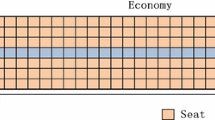Abstract
The purpose of this paper is to develop a new pedestrian-following model based on the properties of the aircraft boarding process. The passengers’ motion trail, the number of interfaces, the total aircraft boarding time, the wasted time that is resulted by the interfaces and the effective aircraft boarding time are investigated in detail. The numerical results illustrate that the new model can qualitatively describe some dynamic properties of the aircraft boarding process.
Similar content being viewed by others
References
Van Landeghem, H., Beuselinck, A.: Reducing passenger boarding time in airplanes: a simulation based approach. Eur. J. Oper. Res. 142, 294–308 (2002)
David, C.N., Kathleen, L.M.: A study of the airline boarding problem. J. Air Transp. Manag. 14, 197–204 (2008)
Yasuda, H., Fujitaka, K.: A study on the necessity of boarding control for international flights. Int. Congr. Ser. 1276, 434–435 (2005)
Steffen, J.H.: Optimal boarding method for airline passengers. J. Air Transp. Manag. 14, 146–150 (2008)
Bachmat, E., Elkin, M.: Bounds on the performance of back-to-front airplane boarding policies. Oper. Res. Lett. 36, 597–601 (2008)
Ferrari, P., Nagel, K.: Robustness of efficient passenger boarding strategies for airplanes. J. Transp. Res. Board 1915, 44–54 (2005)
Kirchner, A., Klüpfel, H., Nishinari, K., Schadschneider, A., Schreckenberg, M.: Simulation of competitive egress behavior: comparison with aircraft evacuation data. Physica A 324, 689–697 (2003)
Bazargan, M.: A linear programming approach for aircraft boarding strategy. Eur. J. Oper. Res. 183, 394–411 (2007)
Hughes, R.L.: A continuum theory for the flow of pedestrians. Transp. Res. B 36, 507–535 (2002)
Xia, Y., Wong, S.C., Zhang, M.P., Shu, C.W., Lam, W.H.K.: An efficient discontinuous Galerkin method on triangular meshes for a pedestrian flow model. Int. J. Numer. Methods Eng. 76, 337–350 (2008)
Huang, L., Wong, S.C., Zhang, M.P., Shu, C.W., Lam, W.H.K.: Revisiting Hughes’ dynamic continuum model for pedestrian flow and the development of an efficient solution algorithm. Transp. Res. B 43, 127–141 (2009)
Xia, Y., Wong, S.C., Shu, C.W.: Dynamic continuum pedestrian flow model with memory effect. Phys. Rev. E 79, 066113 (2009)
Robin, Th., Antonini, G., Bierlaire, M., Cruz, J.: Specification, estimation and validation of a pedestrian walking behavior model. Transp. Res. B 43, 36–56 (2009)
Helbing, D., Molnár, P.: Social force model for pedestrian dynamics. Phys. Rev. E 51, 4282–4286 (1995)
Helbing, D., Farkas, I., Vicsek, T.: Simulating dynamical features of escape panic. Nature 407, 487–490 (2000)
Burstedde, C., Klauck, K., Schadschneider, A., Zittartz, J.: Simulation of pedestrian dynamics using a two-dimensional cellular automaton. Physica A 295, 507–525 (2001)
Kirchner, A., Schadschneider, A.: Simulation of evacuation process using a bionics-inspired cellular automaton model for pedestrian dynamics. Physica A 312, 260–276 (2002)
Victor, J.B., Jeffrey, L.A.: Cellular automata microsimulation for modeling bidirectional pedestrian walkways. Transp. Res. B 35, 293–312 (2001)
Tang, T.Q., Huang, H.J., Shang, H.Y.: A dynamic model for the heterogeneous traffic flow consisting of car, bicycle and pedestrian. Int. J. Mod. Phys. C 21, 159–176 (2010)
Bando, M., Hasebe, K., Nakayama, A., Shibata, A., Sugiyama, Y.: Dynamical model of traffic congestion and numerical simulation. Phys. Rev. E 51, 1035–1042 (1995)
Author information
Authors and Affiliations
Corresponding author
Rights and permissions
About this article
Cite this article
Tang, T., Huang, H. & Shang, H. A new pedestrian-following model for aircraft boarding and numerical tests. Nonlinear Dyn 67, 437–443 (2012). https://doi.org/10.1007/s11071-011-9992-7
Received:
Accepted:
Published:
Issue Date:
DOI: https://doi.org/10.1007/s11071-011-9992-7




